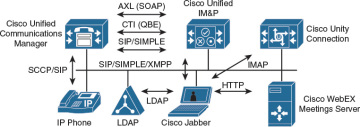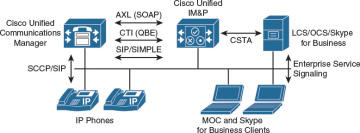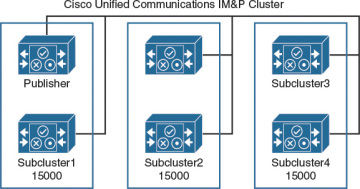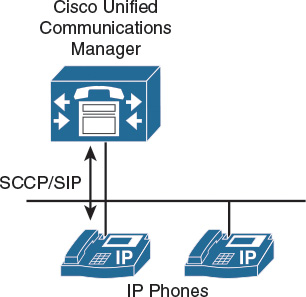Designing and Deploying Cisco Unified IM and Presence
Implementing Cisco Collaboration Applications (CAPPS) Foundation Learning Guide (CCNP Collaboration Exam 300-085 CAPPS)
Let's learn some chapters from this book
Upon completing this chapter, you will be able to do the following:
- Describe native presence in Cisco Unified Communications Manager without Cisco Unified Communications IM and Presence (IM&P) servers
- Describe how the subscribe CSS controls presence watchers
- Describe how presence groups add more granularity to the presence functionality
- Describe the requirements when using Cisco Jabber for presence functionality
- Describe how to integrate a Cisco presence solution within a Microsoft environment in an enterprise
- Describe the characteristics of the Cisco Unified Communications IM&P OVA templates and the required physical resources
- Describe the Cisco Unified Communications IM&P cluster architecture
- Describe how to deploy Cisco Unified Communications IM&P in different scenarios
- Describe how Cisco Jabber discovers services to register
- Describe the Cisco Jabber quality of service issues with trust boundaries
- Describe the different ports that Cisco Jabber uses to communicate
- Describe how to connect Cisco Unified Communications IM&P clusters within the same domain
- Describe how to connect Cisco Unified Communications IM&P clusters that are in different domains
- Describe SIP federations with Microsoft domains
- Describe the state mappings between Cisco Unified Communications IM&P and Microsoft Skype for Business
- Describe the preparation that is necessary to implement a federated presence network
This chapter describes the Cisco Unified Communications IM and Presence (IM&P) architecture and design.
Native presence in Cisco Unified Communications Manager (CUCM) is presented and the different Cisco Unified Communications IM&P approaches are described.
Cisco Unified Communications IM&P can be configured to peer with another Cisco Unified Communications IM&P cluster in the same domain or can be federated with Cisco Unified Communications IM&P clusters in a different domain.
CUCM Presence Introduction
This section describes native presence in CUCM without Cisco Unified Communications IM&P servers, as shown in Figure 14-1.
CUCM offers very limited native presence functionality on IP phones. Although a Cisco Unified Communications IM&P server is not required in this simple example, only these native presence features of the CUCM are available:
- CUCM speed-dial presence: CUCM administratively supports the ability for a speed dial to have presence capabilities via a BLF speed dial. BLF speed dials work as both a speed dial and a presence indicator.
- CUCM call history presence: CUCM administratively supports presence capabilities for call lists and directories on the phone.
- CUCM presence policy: CUCM provides the capability to set policy for users who request presence status.
CUCM Presence
This section describes the integration of external presence entities into the native presence solution.
All presence requests for users, whether inside or outside a cluster, are processed by CUCM, as shown in Figure 14-2.

Figure 14-2 CUCM Native Presence
A CUCM watcher that sends a presence request will receive a direct response, including the presence status, if the watcher and presence entity are both located within the cluster.
If the presence entity exists outside the cluster, CUCM will query the external presence entity through the Session Initiation Protocol (SIP) trunk.
For A watcher that is not in a CUCM cluster, the CUCM can send a presence request off cluster entity by way of a SIP trunk. If the off-cluster entity supports presence, it will respond with the current presence status.
If the off-cluster entity does not support presence, it will reject the presence request with a SIP error response.
Skinny Client Control Protocol (SCCP) endpoints can request the presence status of the indicated presence entity by sending SCCP messages to CUCM.
If the presence entity resides within the CUCM cluster, CUCM responds to the SCCP line-side presence request by sending SCCP messages to the presence watcher that indicate the status of the presence entity.
CUCM uses the term SIP line to represent endpoints supporting SIP that are directly connected and registered to CUCM,
and the term SIP trunk to represent trunks supporting SIP. SIP line-side endpoints acting as presence watchers can send a SIP SUBSCRIBE message to CUCM requesting the presence status of the indicated presence entity.
Want to Earn daily 500 to 800 USD
by selling High demand &
Ultra modern and novel Gadgets online ?
If the presence entity resides outside the CUCM cluster, CUCM routes a SUBSCRIBE request out on the appropriate SIP trunk,
based on the SUBSCRIBE CSS and presence groups. When CUCM receives a SIP NOTIFY response on the trunk that indicates the presence entity status,
it responds to the SCCP line-side presence request by sending SCCP messages to the presence watcher indicating the status of the presence entity.
------------------------------------------------------------------------------
Indicators for Speed-Dial Presence
Table 14-1 describes the native presence indicators on IP phones.
Table 14-1 Cisco Unified Communications Speed-Dial Presence
State | Icon | LED |
Idle |
|
|
Busy |
|
|
Unknown |
|
|
CUCM supports the ability for a speed dial to have presence capabilities via a Busy Lamp Field (BLF) speed dial.
BLF speed dials work as both a speed dial and a presence indicator. Only the system administrator can configure a BLF speed dial.
A system user is not allowed to configure or modify a BLF speed dial.
The administrator must configure the BLF speed dial with a target directory number that is resolvable to a directory number within the CUCM cluster or an entity accessed by a route pattern at accessed by a SIP trunk destination.
The BLF speed-dial indicator is a line-level indicator and not a device-level indicator.
The BLF speed-dial indicators show the real-time state of the monitored phone:
- Idle: The user phone is on hook and the user is available.
- Busy: The user phone is off hook and the user is not available.
- Unknown: The real-time state cannot be determined. The phone might be disconnected, the users are not in the same presence group, or the users are not allowed to see the presence status.
CUCM Call Presence
Call list presence capabilities are controlled via the BLF for the Call Lists enterprise parameter within CUCM Administration.
The BLF for the Call Lists enterprise parameter impacts all pages that use the phone Directories button and it is set on a global basis, as shown in Figure 14-3.

Figure 14-3 CUCM Presence Call History on an IP Phone
-----------------------------------------------------------------------------------------------------------------------------------------
CUCM Subscribe CSS
Figure 14-4 describes how the subscribe CSS controls presence watchers.

Figure 14-4 CUCM Subscribe CSS
CUCM provides the capability to set policy for users who request presence status:
- Configure a CSS to route SIP SUBSCRIBE messages for presence status.
- Configure presence groups with which watchers can be associated, that specify rules for viewing the presence status of presence entities that are associated with another group.
The first aspect of presence policies for CUCM is the subscribe CSS.
CUCM uses the subscribe CSS to determine how to route presence requests.
Presence requests are SUBSCRIBE messages with the Event field set to Presence.
These messages are sent from the watcher, which can be a phone or a trunk.
The subscribe CSS is associated with the watcher and lists the partitions that the watcher is allowed to see.
This mechanism provides an additional level of granularity for the presence SUBSCRIBE requests to be routed independently from the normal call-processing CSS.
With the subscribe CSS set to <None>, BLF speed dial and call list presence status does not work (if no directory number or route pattern is associated with the <None> partition) and the subscription message is rejected as “user unknown.”
When a valid subscribe CSS is specified, the indicators work and the SUBSCRIBE messages are accepted and routed properly.
-----------------------------------------------------------------------------------------------------------------------------------------
CUCM Presence Groups
Figure 14-5 illustrates how presence groups add more granularity to the presence functionality.

Figure 14-5 CUCM Presence Groups
Devices, directory numbers, and users can be assigned to a presence group, and by default, all users are assigned to the same standard presence group.
By default, if the subscribe calling search space (CSS) permits, all watchers can watch all other entities.
A presence group controls the destinations that a watcher can monitor, based on the association of a user with a defined presence group;
for example, employees watching managers is disallowed, but managers watching employees is allowed.
When multiple presence groups are defined, as shown in the picture, the Inter-Presence Group Subscribe Policy service parameter is applied.
If one group has a relationship to another group via the Use System Default setting, rather than being allowed or disallowed, the value of this service parameter will take effect.
If the Inter-Presence Group Subscribe Policy service parameter is set to Disallowed, CUCM will block the request even if the subscribe CSS allows it.
Observe the following guidelines when configuring presence within CUCM:
- Define a presence policy for presence users.
- Use subscribe CSSs to control the routing of a watcher presence-based SIP SUBSCRIBE message to the correct destinations.
- Use presence groups to define sets of similar users and to define whether presence status updates of other user groups are allowed or disallowed.
- Call list presence capabilities are enabled on a global basis. The user status can be secured by using a presence policy.
- BLF speed dials are administratively controlled and are not impacted by the presence policy configuration.
Cisco Unified Communications IM&P Introduction
Figure 14-6 illustrates the components when using Cisco Jabber for presence functionality.

Figure 14-6 CUCM IM&P
Integrating Cisco WebEx Meetings Server,
Cisco Unity Connection, and other applications into the presence network offers a feature-rich communications environment with the Cisco Jabber client application as the single interface for voice and video calls,
voice-mail playback, web conferencing, and integrated directories.
The following are available features in this deployment:
- Real-time availability: This feature provides real-time availability of other Cisco Jabber users.
- Contact list: This feature allows users to search the corporate directory from one easy-to-use interface to locate contacts quickly. Simply click to call.
- Media escalation: This feature provides the ability to add communication methods during a session; for example, add video to an existing audio session, or add web conferencing to an existing audio or video session.
- Click-to-call: This feature provides the ability to dial from the contact list by using the integrated softphone or an associated IP phone.
- Integrated voice and video calling: This feature provides the ability to exchange ideas face to face with a coordinated video display on the PC screen and audio conversation with the softphone. Users can place video calls to other users.
- IP phone association: This feature allows users to use Cisco Jabber to control an IP phone and make or receive calls.
- Conferencing: This feature allows users to create multiparty voice or video conferencing sessions by simply merging conversation sessions by using the Cisco Jabber intuitive interface.
Want to Earn daily 500 to 800 USD
by selling High demand &
Ultra modern and novel Gadgets online ?
- Web conferencing: This feature allows users to launch a web conferencing session immediately to share content, such as a presentation, with others.
- Voice messages: This feature allows users to access Cisco Unity Connection voice-mail messages—view, play back, sort, and delete messages—all from the same client application.
Microsoft Integration
Figure 14-7 illustrates how to integrate a Cisco presence solution within a Microsoft environment in an enterprise.

Figure 14-7 Cisco to Microsoft Integration
Cisco Unified Communications IM&P implements a Computer-Supported Telephony Application to Computer Telephony Integration (CSTA-to-CTI) bridge to integrate with Microsoft Office Communications Server (OCS) and Skype for Business interfaces.
Cisco Unified Communications IM&P includes the following CTI gateway functionalities:
- CSTA over SIP interface to Microsoft Skype for Business and OCS server is available.
- A CTI interface to CUCM is available.
- A linkage of the older Microsoft Office Communicator (MOC) and the current Microsoft Skype for Business client and CUCM endpoints for a specific user is realized, which supports monitoring of CUCM endpoint activity via Microsoft clients. Support for call establishment and call modification for CUCM endpoints via Microsoft clients is also included.
- The functionality provides click to dial, phone hook status reporting, and general phone control directly from the Microsoft client.
OVA Template for Cisco Unified Communications IM&P
Table 14-2 presents the available VM overlays for Cisco Unified Communications IM&P installations.
Table 14-2 OVA Template for Cisco Unified Communications IM&P
User Capacity | vCPUs | Memory (GB) | vDisk | vNIC |
500 | 1 | 2 | 1 x 80 GB | 1 |
1000 | 1 | 2 | 1 x 80 GB | 1 |
2000 | 1 | 4 | 1 x 80 GB | 1 |
5000 | 2 | 4 | 2 x 80 GB | 1 |
15,000 | 4 | 8 | 2 x 80 GB | 1 |
The 500-user OVA template is the minimum VM configuration for use with the Cisco Hosted Collaboration Solution.
The 1000-user OVA template is only supported for Cisco Business Edition 6000.
Another important factor is the number of presence or IM users. When using only IM, without presence, higher user counts are supported per server and cluster:
- 500 full UC users, 1000 IM-only users, 6 single nodes, or subclusters
- 1000 full UC users, 2000 IM-only users
- 2000 full UC users per node, 2000 IM-only users, 3 single nodes, or subclusters
- 5000 full UC users, 12,500 IM-only users, 6 single nodes, or subclusters
- 15,000 full UC users, 25,000 IM-only users, 6 single nodes, or subclusters
IM&P Service maximum capacities per cluster are as follows:
- Cisco Unified Communications mode: In this mode, IM&P service integrates into a full Cisco Collaboration Systems environment to provide an enterprise-class IM&P solution in conjunction with the full suite of Cisco Collaboration Systems services,
- including voice and video. In this mode, IM&P service supports Cisco Collaboration Systems clients, such as the Cisco Jabber platform,
- and Cisco Jabber SDK, as well as third-party Extensible Messaging and Presence Protocol (XMPP) standard-based clients.
- When operating in Cisco Unified Communications mode, IM&P Service scales up to a maximum of 45,000 users in a multinode CUCM cluster environment.
- IM-only user mode: IM&P Service provides an enterprise-class IM&P solution for enterprise users who are not using CUCM for call control.
- In IM-only user mode, IM&P Service supports Cisco Collaboration Systems clients such as the Cisco Jabber client, and Cisco Jabber SDK for all enterprise-class IM&P services.
- IM&P Service also supports the ability for third-party XMPP standard-based clients to interface with CUCM for IM&P services.
- When operating in Cisco IM-only user mode, IM&P Service scales up to a maximum of 75,000 users in a multinode cluster environment.
- Users deployed as part of the Jabber for Everyone offer without voice and video services operate in IM-only user mode.
- Microsoft Skype for Business interoperability mode (or Microsoft Remote Call Control): In this mode, IM&P Service allows Microsoft Skype for Business users on a PC to interoperate with Cisco Unified IP phones on CUCM by providing click-to-dial and associated phone monitoring capabilities.
- Interoperability is made available by activating Microsoft Skype for Business interoperability mode in IM&P Service and configuring Microsoft Skype for Business users. When operating in this mode,
- IM&P Service scales up to 40,000 Microsoft Office Communicator users per CUCM cluster.
Cisco Unified Communications IM&P Cluster
Figure 14-8 illustrates the Cisco Unified Communications IM&P cluster architecture maximum option of up to six servers per cluster.

Figure 14-8 Cisco Unified IM&P Cluster
A cluster can be formed to scale Cisco Unified Communications IM&P to support up to 45,000 licensed presence users.
The Cisco Unified Communications IM&P server uses the same virtualization approach that is used by CUCM or Cisco Unity Connection.
Cisco Unified Communications IM&P consists of up to six servers, including one server that is designated as a publisher.
Cisco Unified Communications IM&P utilizes the same architectural concepts as the CUCM publisher and subscriber.
Within a Cisco Unified Communications IM&P cluster, individual servers can be grouped to form a subcluster, and the subcluster can have at most two servers that are associated with it.
The figure shows the topology for a Cisco Unified Communications IM&P cluster.
The Cisco Unified Communications IM&P cluster can also have mixed subclusters, where one subcluster is configured with two servers while other subclusters contain a single server.
The Cisco Unified Communications IM&P servers form their own cluster even if they are integrated as subscribers in the CUCM cluster.
-----------------------------------------------------------------------------------
you learnt all this from the book below.
Get the book here
https://itexamtools.com/what-is-the-difference-between-python-and-ruby/ |
https://itexamtools.com/7-skills-employers-of-the-future-will-be-looking-for/ |
https://itexamtools.com/aws-masterclass-go-serverless-with-aws-lambda-aws-aurora/ |
https://itexamtools.com/azure-fundamentals-how-to-pass-the-az-900-exam/ |
https://itexamtools.com/what-is-a-business-intelligence-dashboard/ https://itexamtools.com/affiliate-bots-v2-07/ https://itexamtools.com/online-social-media-jobs-product-review/ https://itexamtools.com/recession-free-profits-product-review/ https://itexamtools.com/niche-marketing-kit-product-review/ https://itexamtools.com/click-wealth-system-product-review/ https://itexamtools.com/livpure-product-review/ https://itexamtools.com/ikaria-lean-belly-juice-product-review/ |
Want to Earn daily 500 to 800 USD
by selling High demand &
Ultra modern and novel Gadgets online ?


























No comments: